Analysis of ABC Company Limited's Financial Performance and Budgeting
VerifiedAdded on 2023/04/08
|9
|1618
|500
Report
AI Summary
This management accounting report analyzes the financial performance of ABC Company Limited, focusing on margin analysis, product costing, and constraint analysis to evaluate profitability. The report delves into the budgeting process, outlining its major functions and the advantages and disadvantages of budgetary control systems. It includes a detailed budgetary planning section with sales, cash collection, production, and raw material purchase budgets. Furthermore, the report applies budgetary control techniques, calculating raw material variances, including price and usage variances, and provides a cost reconciliation statement. Finally, the report offers recommendations to management based on the findings of the analysis, particularly concerning raw material procurement and cost control. The report is well-structured, using relevant formulas and providing detailed calculations and recommendations.
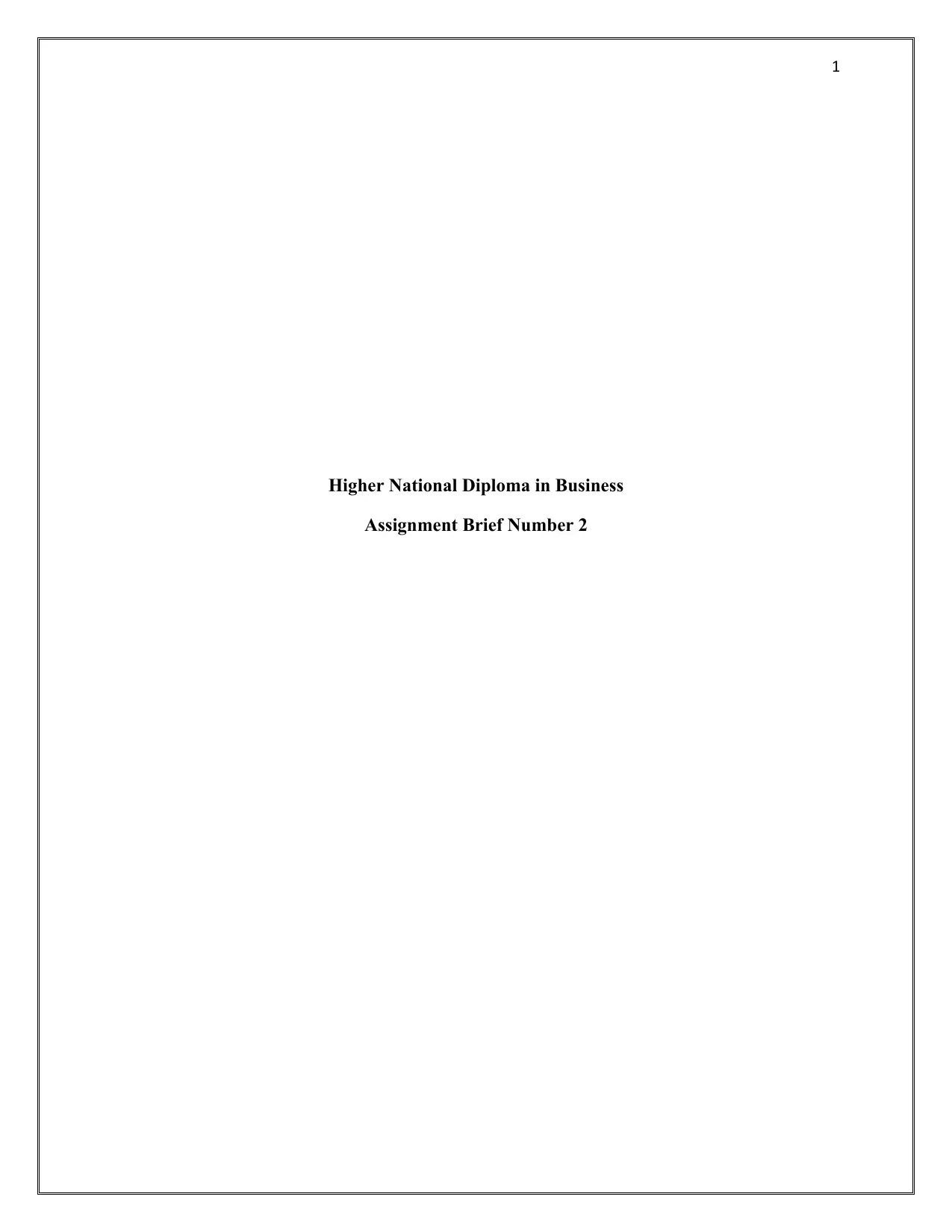
1
Higher National Diploma in Business
Assignment Brief Number 2
Higher National Diploma in Business
Assignment Brief Number 2
Paraphrase This Document
Need a fresh take? Get an instant paraphrase of this document with our AI Paraphraser

2
Contents
Part A: Analysis and evaluation of ABC Company Limited financial performance and
recommendations.............................................................................................................................3
Part B: Budgeting Process...............................................................................................................4
B.1: Major Functions of Budgeting Process................................................................................4
B.2: Advantages and disadvantages in operating a budgetary control system............................4
Part C: Budgetary Planning.............................................................................................................5
Part D: Budgetary Control...............................................................................................................7
D1: Raw Material Variance.........................................................................................................7
D.2: Raw material price and usage variances..............................................................................7
D.3: Cost reconciliation statement reconciling budgeted and actual raw material costs for the
month of January..........................................................................................................................8
D.4: Report to the manager on findings and recommendations...................................................8
References........................................................................................................................................9
Contents
Part A: Analysis and evaluation of ABC Company Limited financial performance and
recommendations.............................................................................................................................3
Part B: Budgeting Process...............................................................................................................4
B.1: Major Functions of Budgeting Process................................................................................4
B.2: Advantages and disadvantages in operating a budgetary control system............................4
Part C: Budgetary Planning.............................................................................................................5
Part D: Budgetary Control...............................................................................................................7
D1: Raw Material Variance.........................................................................................................7
D.2: Raw material price and usage variances..............................................................................7
D.3: Cost reconciliation statement reconciling budgeted and actual raw material costs for the
month of January..........................................................................................................................8
D.4: Report to the manager on findings and recommendations...................................................8
References........................................................................................................................................9
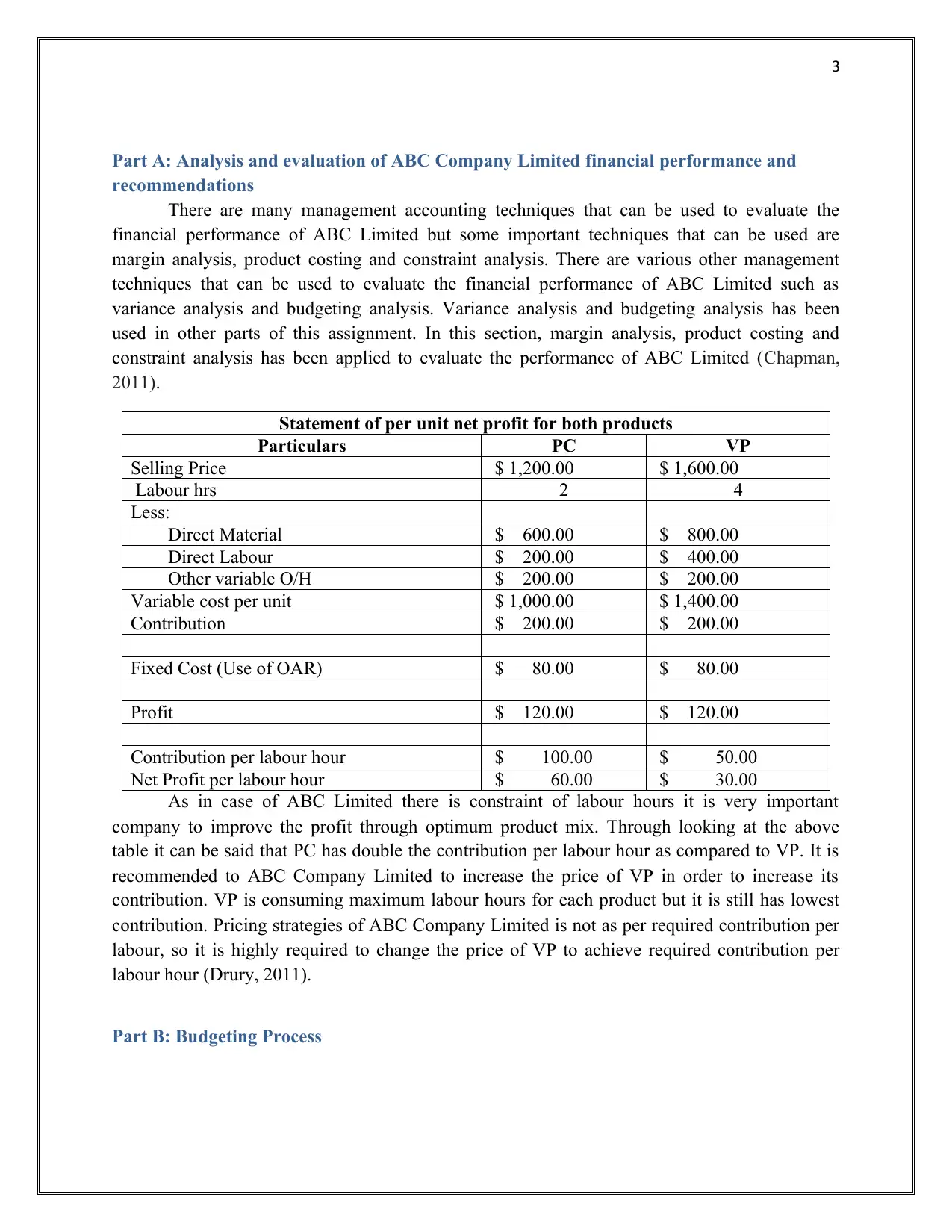
3
Part A: Analysis and evaluation of ABC Company Limited financial performance and
recommendations
There are many management accounting techniques that can be used to evaluate the
financial performance of ABC Limited but some important techniques that can be used are
margin analysis, product costing and constraint analysis. There are various other management
techniques that can be used to evaluate the financial performance of ABC Limited such as
variance analysis and budgeting analysis. Variance analysis and budgeting analysis has been
used in other parts of this assignment. In this section, margin analysis, product costing and
constraint analysis has been applied to evaluate the performance of ABC Limited (Chapman,
2011).
Statement of per unit net profit for both products
Particulars PC VP
Selling Price $ 1,200.00 $ 1,600.00
Labour hrs 2 4
Less:
Direct Material $ 600.00 $ 800.00
Direct Labour $ 200.00 $ 400.00
Other variable O/H $ 200.00 $ 200.00
Variable cost per unit $ 1,000.00 $ 1,400.00
Contribution $ 200.00 $ 200.00
Fixed Cost (Use of OAR) $ 80.00 $ 80.00
Profit $ 120.00 $ 120.00
Contribution per labour hour $ 100.00 $ 50.00
Net Profit per labour hour $ 60.00 $ 30.00
As in case of ABC Limited there is constraint of labour hours it is very important
company to improve the profit through optimum product mix. Through looking at the above
table it can be said that PC has double the contribution per labour hour as compared to VP. It is
recommended to ABC Company Limited to increase the price of VP in order to increase its
contribution. VP is consuming maximum labour hours for each product but it is still has lowest
contribution. Pricing strategies of ABC Company Limited is not as per required contribution per
labour, so it is highly required to change the price of VP to achieve required contribution per
labour hour (Drury, 2011).
Part B: Budgeting Process
Part A: Analysis and evaluation of ABC Company Limited financial performance and
recommendations
There are many management accounting techniques that can be used to evaluate the
financial performance of ABC Limited but some important techniques that can be used are
margin analysis, product costing and constraint analysis. There are various other management
techniques that can be used to evaluate the financial performance of ABC Limited such as
variance analysis and budgeting analysis. Variance analysis and budgeting analysis has been
used in other parts of this assignment. In this section, margin analysis, product costing and
constraint analysis has been applied to evaluate the performance of ABC Limited (Chapman,
2011).
Statement of per unit net profit for both products
Particulars PC VP
Selling Price $ 1,200.00 $ 1,600.00
Labour hrs 2 4
Less:
Direct Material $ 600.00 $ 800.00
Direct Labour $ 200.00 $ 400.00
Other variable O/H $ 200.00 $ 200.00
Variable cost per unit $ 1,000.00 $ 1,400.00
Contribution $ 200.00 $ 200.00
Fixed Cost (Use of OAR) $ 80.00 $ 80.00
Profit $ 120.00 $ 120.00
Contribution per labour hour $ 100.00 $ 50.00
Net Profit per labour hour $ 60.00 $ 30.00
As in case of ABC Limited there is constraint of labour hours it is very important
company to improve the profit through optimum product mix. Through looking at the above
table it can be said that PC has double the contribution per labour hour as compared to VP. It is
recommended to ABC Company Limited to increase the price of VP in order to increase its
contribution. VP is consuming maximum labour hours for each product but it is still has lowest
contribution. Pricing strategies of ABC Company Limited is not as per required contribution per
labour, so it is highly required to change the price of VP to achieve required contribution per
labour hour (Drury, 2011).
Part B: Budgeting Process
⊘ This is a preview!⊘
Do you want full access?
Subscribe today to unlock all pages.

Trusted by 1+ million students worldwide
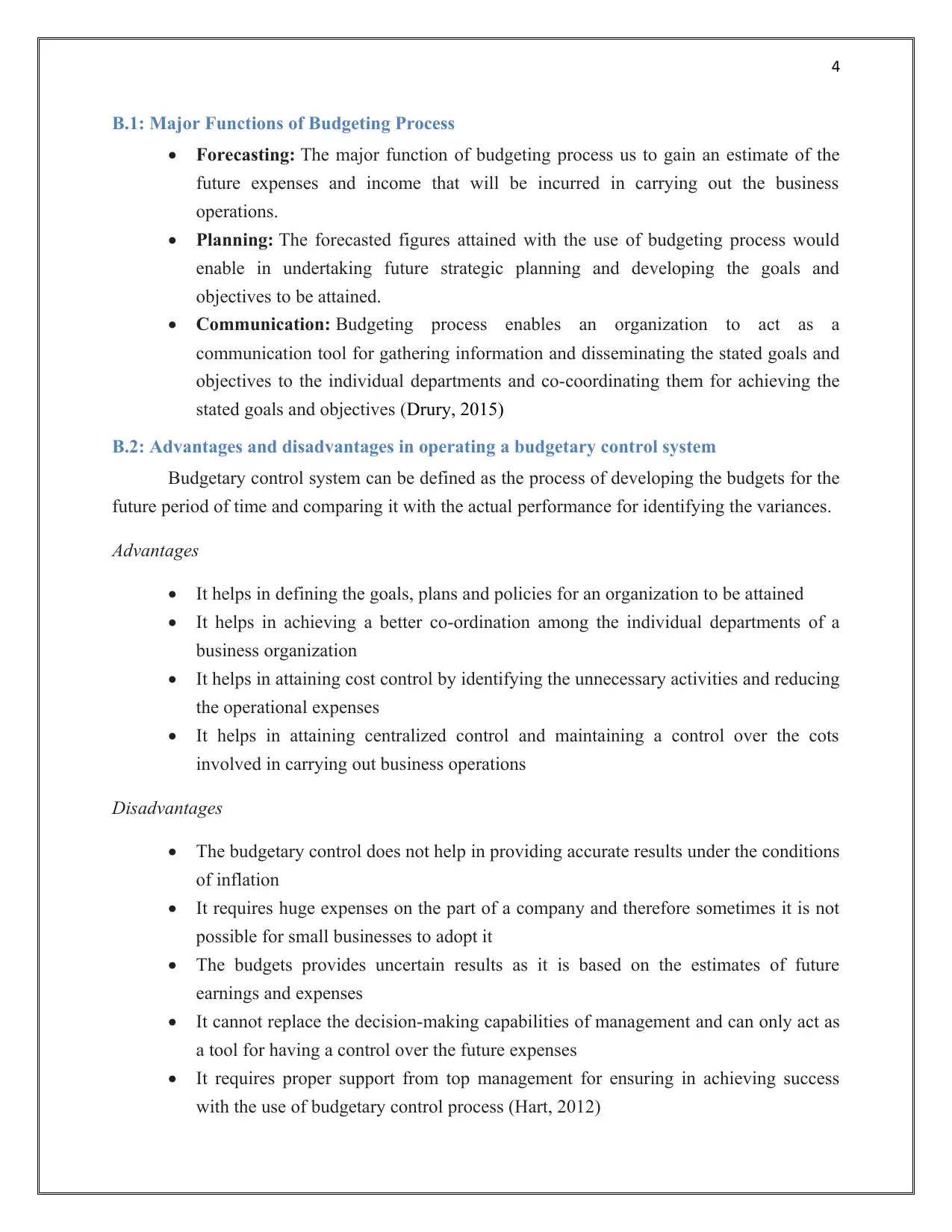
4
B.1: Major Functions of Budgeting Process
Forecasting: The major function of budgeting process us to gain an estimate of the
future expenses and income that will be incurred in carrying out the business
operations.
Planning: The forecasted figures attained with the use of budgeting process would
enable in undertaking future strategic planning and developing the goals and
objectives to be attained.
Communication: Budgeting process enables an organization to act as a
communication tool for gathering information and disseminating the stated goals and
objectives to the individual departments and co-coordinating them for achieving the
stated goals and objectives (Drury, 2015)
B.2: Advantages and disadvantages in operating a budgetary control system
Budgetary control system can be defined as the process of developing the budgets for the
future period of time and comparing it with the actual performance for identifying the variances.
Advantages
It helps in defining the goals, plans and policies for an organization to be attained
It helps in achieving a better co-ordination among the individual departments of a
business organization
It helps in attaining cost control by identifying the unnecessary activities and reducing
the operational expenses
It helps in attaining centralized control and maintaining a control over the cots
involved in carrying out business operations
Disadvantages
The budgetary control does not help in providing accurate results under the conditions
of inflation
It requires huge expenses on the part of a company and therefore sometimes it is not
possible for small businesses to adopt it
The budgets provides uncertain results as it is based on the estimates of future
earnings and expenses
It cannot replace the decision-making capabilities of management and can only act as
a tool for having a control over the future expenses
It requires proper support from top management for ensuring in achieving success
with the use of budgetary control process (Hart, 2012)
B.1: Major Functions of Budgeting Process
Forecasting: The major function of budgeting process us to gain an estimate of the
future expenses and income that will be incurred in carrying out the business
operations.
Planning: The forecasted figures attained with the use of budgeting process would
enable in undertaking future strategic planning and developing the goals and
objectives to be attained.
Communication: Budgeting process enables an organization to act as a
communication tool for gathering information and disseminating the stated goals and
objectives to the individual departments and co-coordinating them for achieving the
stated goals and objectives (Drury, 2015)
B.2: Advantages and disadvantages in operating a budgetary control system
Budgetary control system can be defined as the process of developing the budgets for the
future period of time and comparing it with the actual performance for identifying the variances.
Advantages
It helps in defining the goals, plans and policies for an organization to be attained
It helps in achieving a better co-ordination among the individual departments of a
business organization
It helps in attaining cost control by identifying the unnecessary activities and reducing
the operational expenses
It helps in attaining centralized control and maintaining a control over the cots
involved in carrying out business operations
Disadvantages
The budgetary control does not help in providing accurate results under the conditions
of inflation
It requires huge expenses on the part of a company and therefore sometimes it is not
possible for small businesses to adopt it
The budgets provides uncertain results as it is based on the estimates of future
earnings and expenses
It cannot replace the decision-making capabilities of management and can only act as
a tool for having a control over the future expenses
It requires proper support from top management for ensuring in achieving success
with the use of budgetary control process (Hart, 2012)
Paraphrase This Document
Need a fresh take? Get an instant paraphrase of this document with our AI Paraphraser
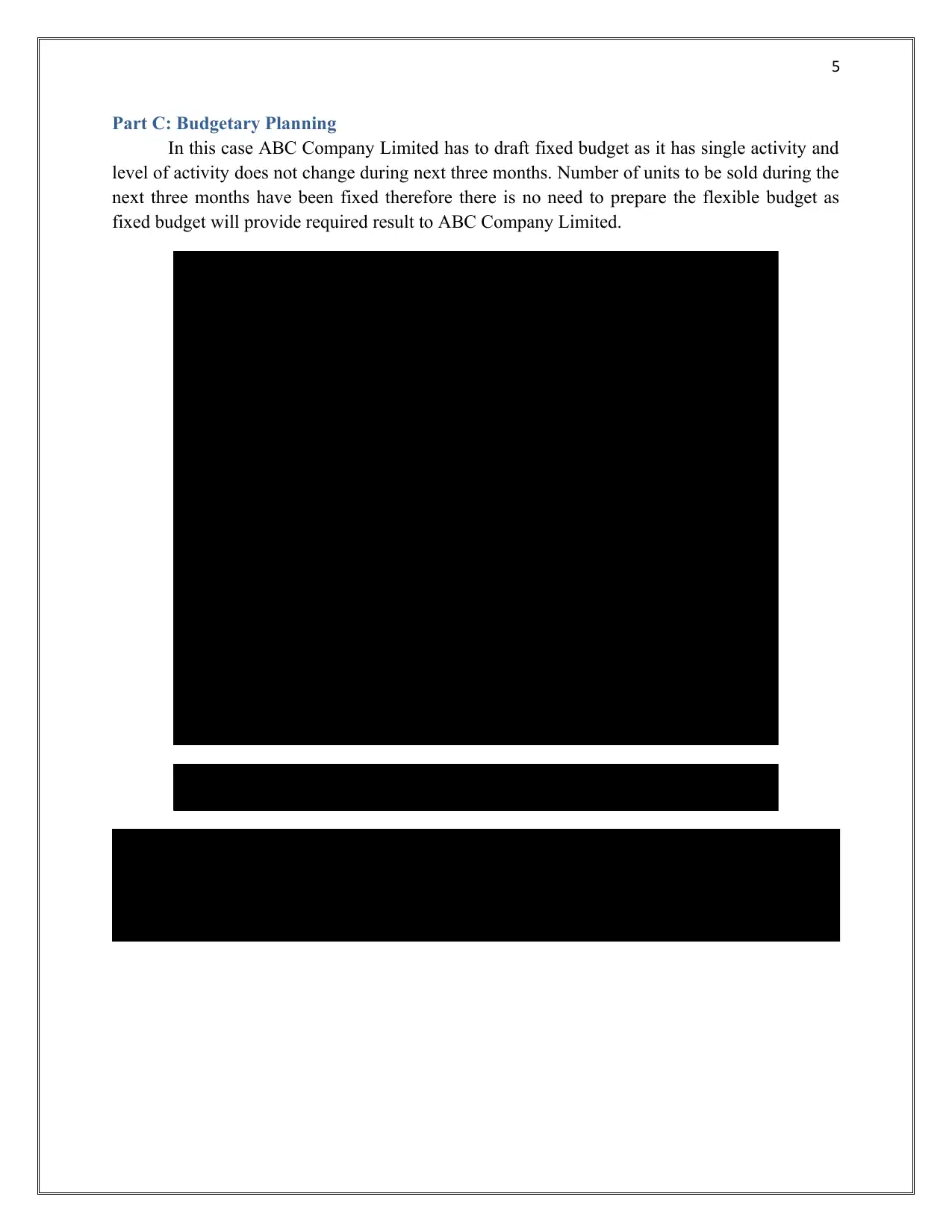
5
Part C: Budgetary Planning
In this case ABC Company Limited has to draft fixed budget as it has single activity and
level of activity does not change during next three months. Number of units to be sold during the
next three months have been fixed therefore there is no need to prepare the flexible budget as
fixed budget will provide required result to ABC Company Limited.
Estimated Contrbution 600.00$ per unit
Month Units Sales
January 3000
February 3000
March 4000
Total Production Cost 200.00$
Cost of each raw material unit 70.00$
Variable Cost (Direct Material Only) ($70*2) 140.00$
Actual Sales of previous month December 2500 Units
Raw material units purchased in last
December 50000 Units
Raw material consumed in December 5000 Units
Raw material stock remain as on 1st January 45000 Units
Given Information
Selling Price of each unit of IP
Selling Price of each unit of IP $600+$140 740.00$
Contribution + Variable Cost
Particulars January Febuary March
Unit Sold 3000 3000 4000
Unit Selling price 740.00$ 740.00$ 740.00$
Total Sales 2,220,000.00$ 2,220,000.00$ 2,960,000.00$
Sales Budget
Part C: Budgetary Planning
In this case ABC Company Limited has to draft fixed budget as it has single activity and
level of activity does not change during next three months. Number of units to be sold during the
next three months have been fixed therefore there is no need to prepare the flexible budget as
fixed budget will provide required result to ABC Company Limited.
Estimated Contrbution 600.00$ per unit
Month Units Sales
January 3000
February 3000
March 4000
Total Production Cost 200.00$
Cost of each raw material unit 70.00$
Variable Cost (Direct Material Only) ($70*2) 140.00$
Actual Sales of previous month December 2500 Units
Raw material units purchased in last
December 50000 Units
Raw material consumed in December 5000 Units
Raw material stock remain as on 1st January 45000 Units
Given Information
Selling Price of each unit of IP
Selling Price of each unit of IP $600+$140 740.00$
Contribution + Variable Cost
Particulars January Febuary March
Unit Sold 3000 3000 4000
Unit Selling price 740.00$ 740.00$ 740.00$
Total Sales 2,220,000.00$ 2,220,000.00$ 2,960,000.00$
Sales Budget
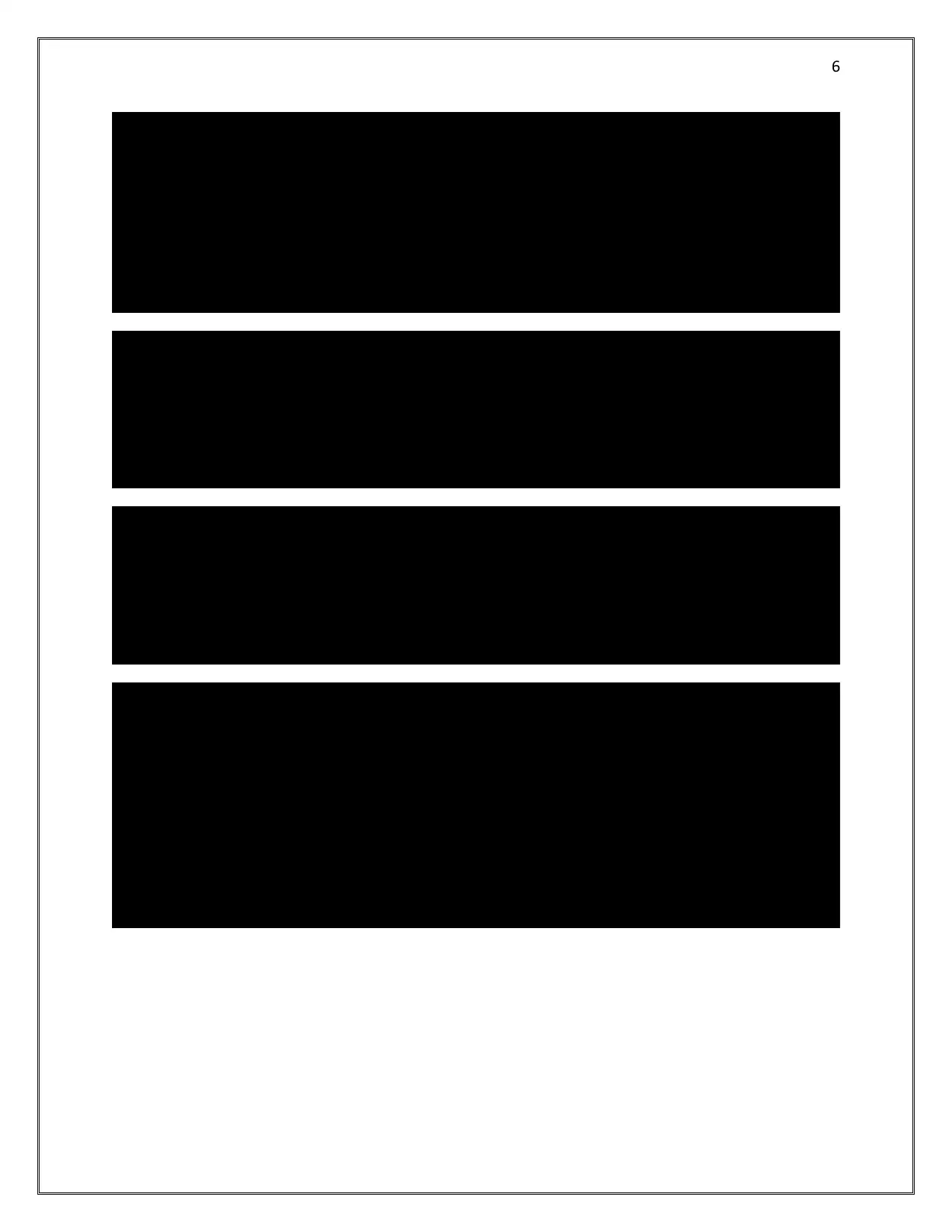
6
Particulars January Febuary March
Total Sales 2,220,000.00$ 2,220,000.00$ 2,960,000.00$
Cash Collected
40% in current month 888,000.00$ 888,000.00$ 1,184,000.00$
60% in following month (2500 units sold in
December) 1,110,000.00$ 1,332,000.00$ 1,332,000.00$
Total Cash Collections 1,998,000.00$ 2,220,000.00$ 2,516,000.00$
Cash collection budget from sales
Particulars January Febuary March
Sales Units 3000 3000 4000
Production Units Required 3000 3000 4000
Add: Opening stock 0 0 0
Less: Closing Stock 0 0 0
Production Units 3000 3000 4000
Production Budget (Production units is equal to sales units of current month)
Particulars January Febuary March
Production Units Required 3000 3000 4000
Raw material required per unit of IP 2 2 2
Total Raw Material Required to purchase 6000 6000 8000
Raw material purchase budget in quantity
Particulars January Febuary March
Total Raw Material Required to purchase 6000 6000 8000
Cost per unit 70.00$ 70.00$ 70.00$
Total Cost of Raw material 420,000.00$ 420,000.00$ 560,000.00$
Cash Paid
In the following month (50000 units
purhcased in December) 3,500,000.00$ 420,000.00$ 420,000.00$
Cash payment budget for raw material purchases
Particulars January Febuary March
Total Sales 2,220,000.00$ 2,220,000.00$ 2,960,000.00$
Cash Collected
40% in current month 888,000.00$ 888,000.00$ 1,184,000.00$
60% in following month (2500 units sold in
December) 1,110,000.00$ 1,332,000.00$ 1,332,000.00$
Total Cash Collections 1,998,000.00$ 2,220,000.00$ 2,516,000.00$
Cash collection budget from sales
Particulars January Febuary March
Sales Units 3000 3000 4000
Production Units Required 3000 3000 4000
Add: Opening stock 0 0 0
Less: Closing Stock 0 0 0
Production Units 3000 3000 4000
Production Budget (Production units is equal to sales units of current month)
Particulars January Febuary March
Production Units Required 3000 3000 4000
Raw material required per unit of IP 2 2 2
Total Raw Material Required to purchase 6000 6000 8000
Raw material purchase budget in quantity
Particulars January Febuary March
Total Raw Material Required to purchase 6000 6000 8000
Cost per unit 70.00$ 70.00$ 70.00$
Total Cost of Raw material 420,000.00$ 420,000.00$ 560,000.00$
Cash Paid
In the following month (50000 units
purhcased in December) 3,500,000.00$ 420,000.00$ 420,000.00$
Cash payment budget for raw material purchases
⊘ This is a preview!⊘
Do you want full access?
Subscribe today to unlock all pages.

Trusted by 1+ million students worldwide
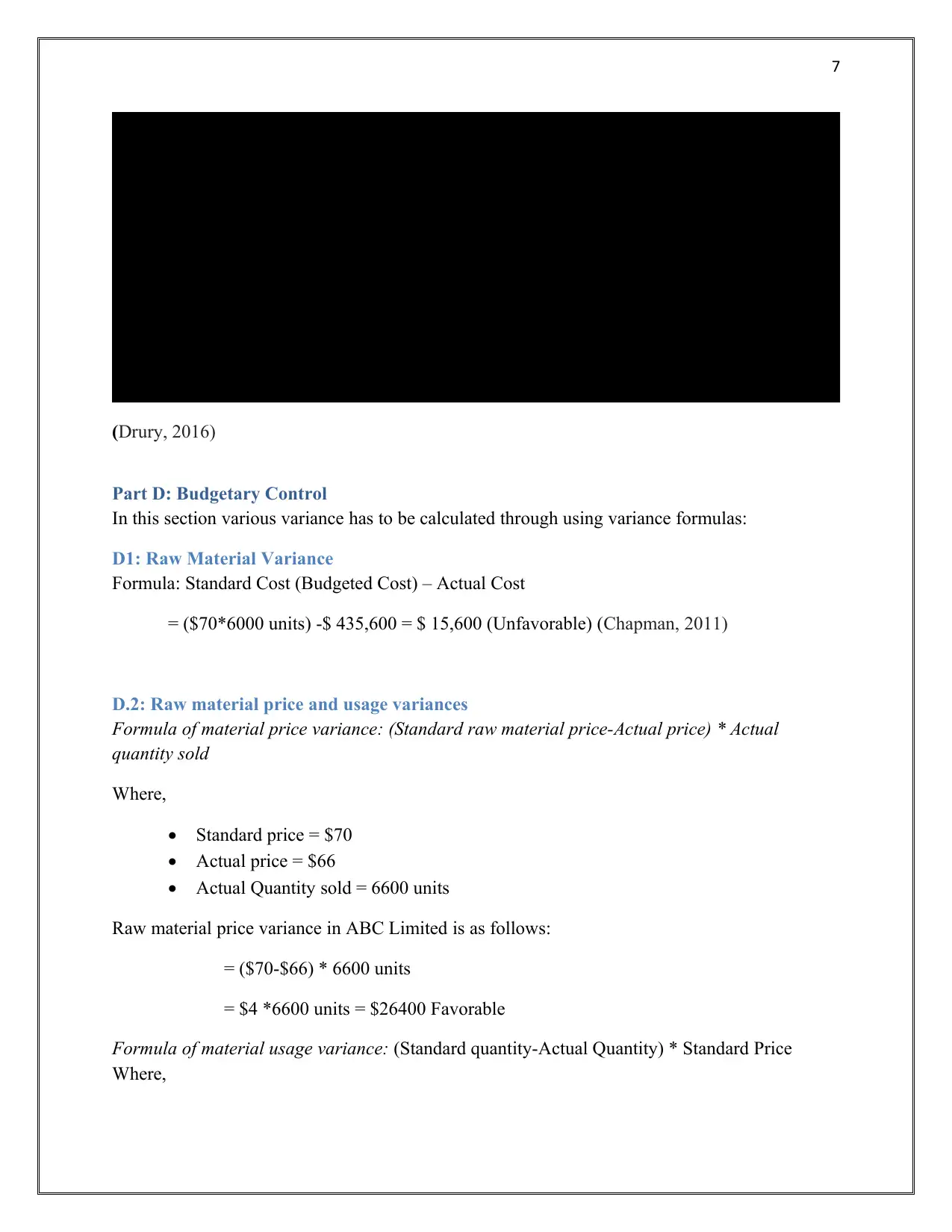
7
Particulars January Febuary March
Cash Collected for Sales 1,998,000.00$ 2,220,000.00$ 2,516,000.00$
Less:
Cash paid for raw material 3,500,000.00$ 420,000.00$ 420,000.00$
Cash paid for purchase of equipment 300,000.00$ 0 0
Total Cash Paid 3,800,000.00$ 420,000.00$ 420,000.00$
Cash Flows (1,802,000.00)$ 1,800,000.00$ 2,096,000.00$
Add: Opening Balance 20000 (1,782,000.00)$ 18,000.00$
Closing Balance (1,782,000.00)$ 18,000.00$ 2,114,000.00$
Monthly cash budget
(Drury, 2016)
Part D: Budgetary Control
In this section various variance has to be calculated through using variance formulas:
D1: Raw Material Variance
Formula: Standard Cost (Budgeted Cost) – Actual Cost
= ($70*6000 units) -$ 435,600 = $ 15,600 (Unfavorable) (Chapman, 2011)
D.2: Raw material price and usage variances
Formula of material price variance: (Standard raw material price-Actual price) * Actual
quantity sold
Where,
Standard price = $70
Actual price = $66
Actual Quantity sold = 6600 units
Raw material price variance in ABC Limited is as follows:
= ($70-$66) * 6600 units
= $4 *6600 units = $26400 Favorable
Formula of material usage variance: (Standard quantity-Actual Quantity) * Standard Price
Where,
Particulars January Febuary March
Cash Collected for Sales 1,998,000.00$ 2,220,000.00$ 2,516,000.00$
Less:
Cash paid for raw material 3,500,000.00$ 420,000.00$ 420,000.00$
Cash paid for purchase of equipment 300,000.00$ 0 0
Total Cash Paid 3,800,000.00$ 420,000.00$ 420,000.00$
Cash Flows (1,802,000.00)$ 1,800,000.00$ 2,096,000.00$
Add: Opening Balance 20000 (1,782,000.00)$ 18,000.00$
Closing Balance (1,782,000.00)$ 18,000.00$ 2,114,000.00$
Monthly cash budget
(Drury, 2016)
Part D: Budgetary Control
In this section various variance has to be calculated through using variance formulas:
D1: Raw Material Variance
Formula: Standard Cost (Budgeted Cost) – Actual Cost
= ($70*6000 units) -$ 435,600 = $ 15,600 (Unfavorable) (Chapman, 2011)
D.2: Raw material price and usage variances
Formula of material price variance: (Standard raw material price-Actual price) * Actual
quantity sold
Where,
Standard price = $70
Actual price = $66
Actual Quantity sold = 6600 units
Raw material price variance in ABC Limited is as follows:
= ($70-$66) * 6600 units
= $4 *6600 units = $26400 Favorable
Formula of material usage variance: (Standard quantity-Actual Quantity) * Standard Price
Where,
Paraphrase This Document
Need a fresh take? Get an instant paraphrase of this document with our AI Paraphraser
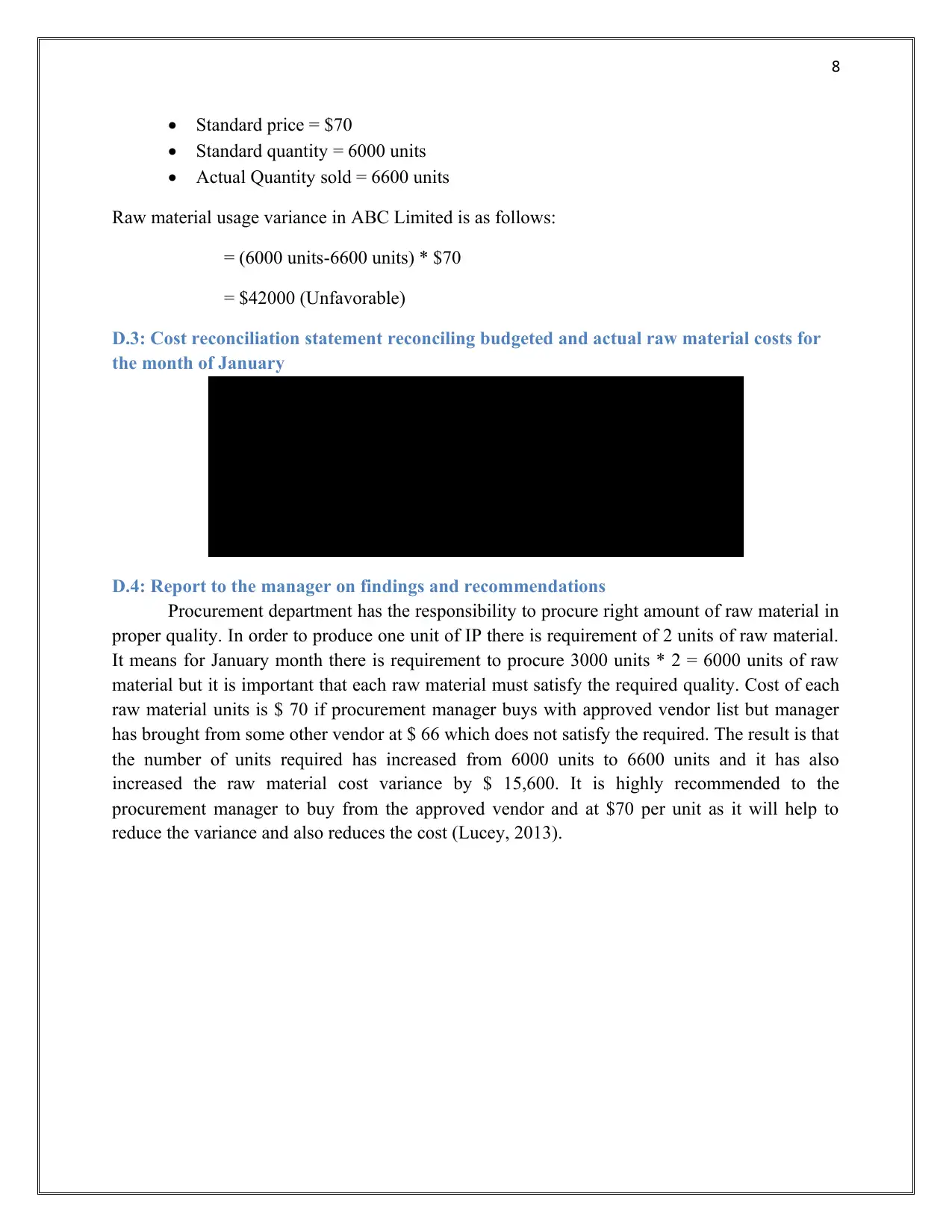
8
Standard price = $70
Standard quantity = 6000 units
Actual Quantity sold = 6600 units
Raw material usage variance in ABC Limited is as follows:
= (6000 units-6600 units) * $70
= $42000 (Unfavorable)
D.3: Cost reconciliation statement reconciling budgeted and actual raw material costs for
the month of January
Particulars Amount
Budgted raw material cost 420,000.00$
($70*6000 units)
Add: Raw material usage variance 42,000.00$
Less: Raw material price variance (26,400.00)$
Actual raw material cost 435,600.00$
Cost Reconcilation Statement
D.4: Report to the manager on findings and recommendations
Procurement department has the responsibility to procure right amount of raw material in
proper quality. In order to produce one unit of IP there is requirement of 2 units of raw material.
It means for January month there is requirement to procure 3000 units * 2 = 6000 units of raw
material but it is important that each raw material must satisfy the required quality. Cost of each
raw material units is $ 70 if procurement manager buys with approved vendor list but manager
has brought from some other vendor at $ 66 which does not satisfy the required. The result is that
the number of units required has increased from 6000 units to 6600 units and it has also
increased the raw material cost variance by $ 15,600. It is highly recommended to the
procurement manager to buy from the approved vendor and at $70 per unit as it will help to
reduce the variance and also reduces the cost (Lucey, 2013).
Standard price = $70
Standard quantity = 6000 units
Actual Quantity sold = 6600 units
Raw material usage variance in ABC Limited is as follows:
= (6000 units-6600 units) * $70
= $42000 (Unfavorable)
D.3: Cost reconciliation statement reconciling budgeted and actual raw material costs for
the month of January
Particulars Amount
Budgted raw material cost 420,000.00$
($70*6000 units)
Add: Raw material usage variance 42,000.00$
Less: Raw material price variance (26,400.00)$
Actual raw material cost 435,600.00$
Cost Reconcilation Statement
D.4: Report to the manager on findings and recommendations
Procurement department has the responsibility to procure right amount of raw material in
proper quality. In order to produce one unit of IP there is requirement of 2 units of raw material.
It means for January month there is requirement to procure 3000 units * 2 = 6000 units of raw
material but it is important that each raw material must satisfy the required quality. Cost of each
raw material units is $ 70 if procurement manager buys with approved vendor list but manager
has brought from some other vendor at $ 66 which does not satisfy the required. The result is that
the number of units required has increased from 6000 units to 6600 units and it has also
increased the raw material cost variance by $ 15,600. It is highly recommended to the
procurement manager to buy from the approved vendor and at $70 per unit as it will help to
reduce the variance and also reduces the cost (Lucey, 2013).
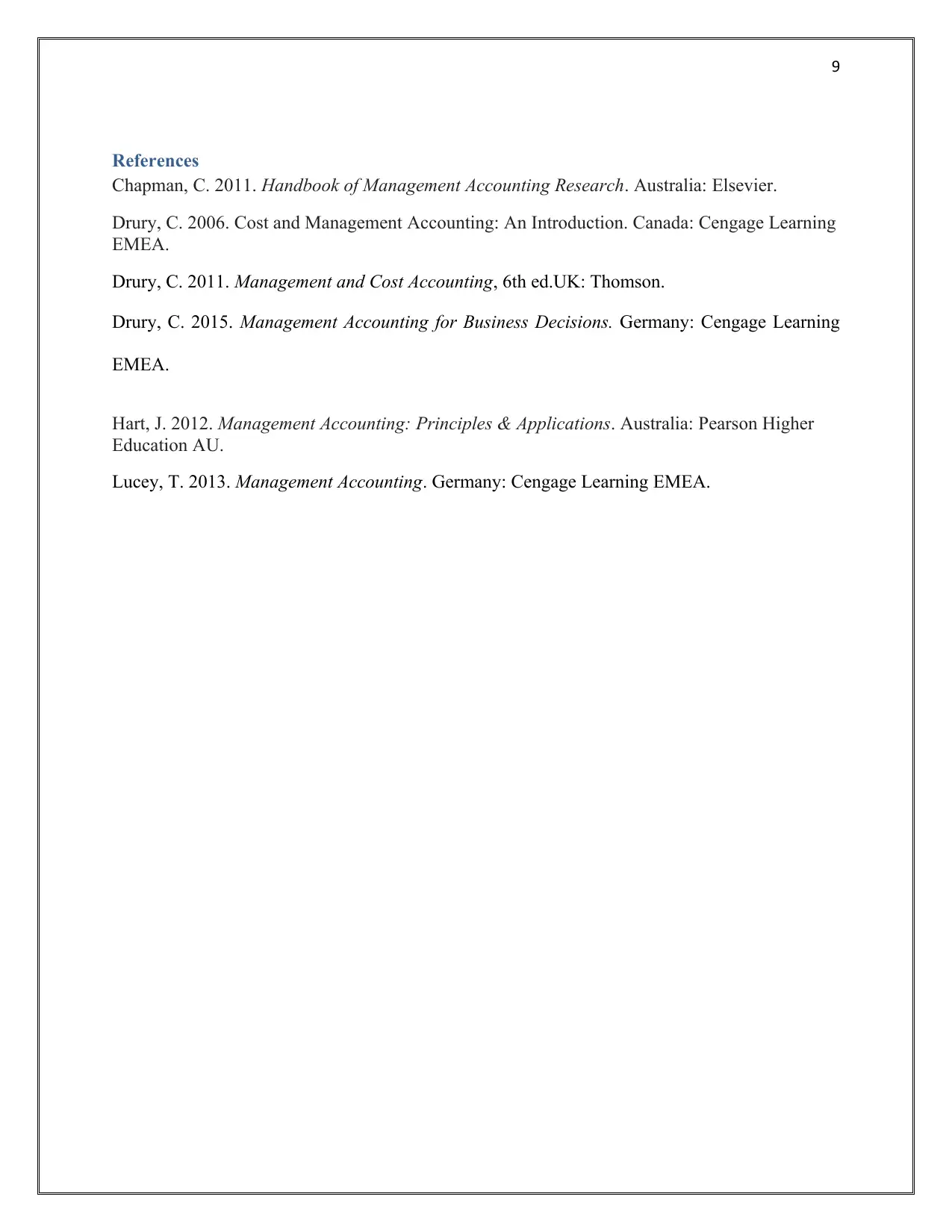
9
References
Chapman, C. 2011. Handbook of Management Accounting Research. Australia: Elsevier.
Drury, C. 2006. Cost and Management Accounting: An Introduction. Canada: Cengage Learning
EMEA.
Drury, C. 2011. Management and Cost Accounting, 6th ed.UK: Thomson.
Drury, C. 2015. Management Accounting for Business Decisions. Germany: Cengage Learning
EMEA.
Hart, J. 2012. Management Accounting: Principles & Applications. Australia: Pearson Higher
Education AU.
Lucey, T. 2013. Management Accounting. Germany: Cengage Learning EMEA.
References
Chapman, C. 2011. Handbook of Management Accounting Research. Australia: Elsevier.
Drury, C. 2006. Cost and Management Accounting: An Introduction. Canada: Cengage Learning
EMEA.
Drury, C. 2011. Management and Cost Accounting, 6th ed.UK: Thomson.
Drury, C. 2015. Management Accounting for Business Decisions. Germany: Cengage Learning
EMEA.
Hart, J. 2012. Management Accounting: Principles & Applications. Australia: Pearson Higher
Education AU.
Lucey, T. 2013. Management Accounting. Germany: Cengage Learning EMEA.
⊘ This is a preview!⊘
Do you want full access?
Subscribe today to unlock all pages.

Trusted by 1+ million students worldwide
1 out of 9
Related Documents
Your All-in-One AI-Powered Toolkit for Academic Success.
+13062052269
info@desklib.com
Available 24*7 on WhatsApp / Email
![[object Object]](/_next/static/media/star-bottom.7253800d.svg)
Unlock your academic potential
Copyright © 2020–2025 A2Z Services. All Rights Reserved. Developed and managed by ZUCOL.





